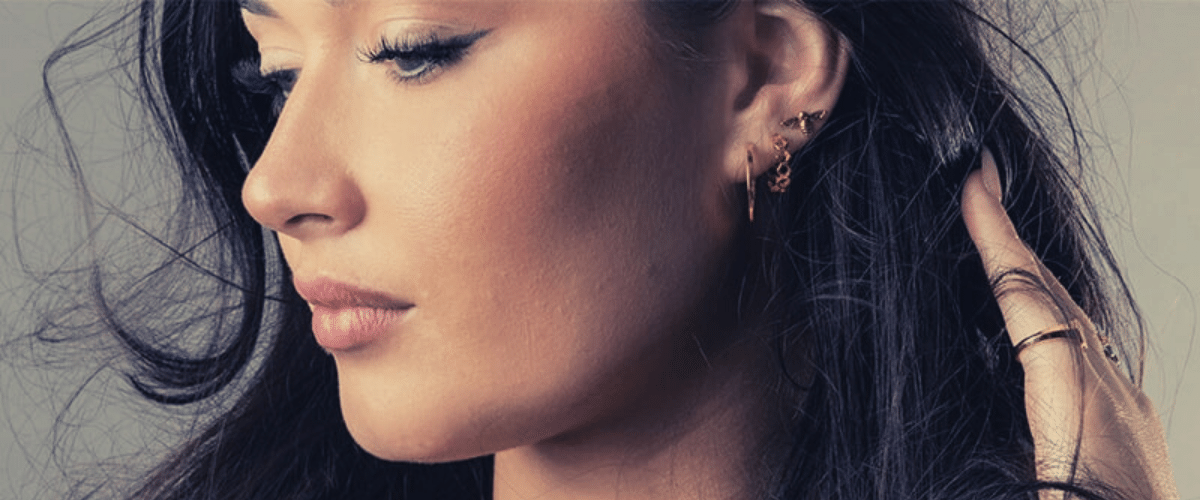We all know getting a brand-new piercing can be daunting- and deciding on which one can be even scarier. With so many styles and variations to choose from the whole prospect can be overwhelming. But don’t worry. Thanks to our complete guide to ear piercings, you can head to your local piercing shop with confidence. Here is our low down on all the info you need to know about ear piercings so you can enjoy your awesome new piece of jewellery worry-free.
TRAGUS PIERCING
A tragus piercing is located on the small bit of cartilage directly in front of the ear canal and is super popular in the ear-piercing world. It is easily noticed as a piercing as it sits closer to the front of the ear, which makes it a favourite for many!
WHAT TYPE OF EARRING TO WEAR
Typically, a barbell or stud will be used as the original jewellery within your piercing. Once your tragus has healed, you can get adventurous. Try trading out your stud or barbell for a hoop. If you’re not feeling confident, make sure to get a piercing professional to change your jewellery.
Healing time: 3 – 12 months depending on how well your individual body heals.
Pain: 5/10
Cost of piercing: £30 – 40
How To Care of your Tragus Piercing:
-
- Wash with salt water or saline solution
- Avoid rough movements
- Take care where wearing headphones
HELIX PIERCING
A Helix Piercing is one of the most popular piercings after the standard lobes. The helix (also known as a cartilage piercing) is located on the upper part of the ear cartilage. A double helix piercing is just two perforations under one another in the same area.
WHAT TYPE OF EARRING TO WEAR
You can adorn your helix piercing with a variety of jewellery, but it is recommended to get pierced originally with a simple stud to reduce the risk of infection. Due to the location, a flat backed stud would likely prove most comfortable (especially while sleeping!) Once you have healed you can change out to more exciting pieces, such as a curved barbell or a hoop- which can look so cute complimented alongside other ear piercings.
Healing time: 6-9 months to heal depending on how well your individual body heals.
Pain: 7/10
Cost of piercing: £25 – 40
How to care for a helix piercing:- Avoid catching your helix piercing on loose strands of hair
- The piercing should be cleaned with saline solution or saltwater 2 times a day.
CONCH PIERCING
A conch piercing is a seriously unique addition to your ear. You can have an inner or outer conch piercing, which makes them totally customisable based on what look you’re going for. An inner conch piercing is a perforation in the middle of your ear to make the perfect stud placement. An outer conch piercing is located slightly closer to the edge of the ear to provide ample room for a hoop around the outside.
WHAT TYPE OF EARRING TO WEAR
There’s a range of earrings that can be worn with a Conch Piercing. A flat-backed conch stud is probably one of the most popular pieces to wear as an inner conch piercing. This is followed by a barbell. A curved, circular or straight barbell all look great with this type of piercing. For an outer conch, you may prefer something like a clicker ring or bead ring to really show off your new piercing.
Healing time: The healing time of a conch piercing can take anywhere between 3-9 months.
Pain: 6/10
Cost of piercing: £30 – 50
How to care for a conch piercing:- Try not to sleep on your piercing until it’s healed
- Avoid catching the piercing on hair or headphones
DAITH PIERCING
A daith piercing is a perforation that hugs the inner cartilage of your ear. This piercing is noted for being a remedy to migraines- although some suggest this is just a placebo. We think cute jewellery and potentially less headaches sounds like a win-win though!
WHAT TYPE OF EARRING TO WEAR
When it comes to the daith piercing,there are a lot of jewellery options to choose from. Typically you’ll be pierced with a curved barbell but once you have healed you can swap it out for some more varied pieces such as hoops, heart shaped hoops or clicker earrings.
Healing time: Anywhere between 6 to 9 months to heal. Ensuring your piercer is experienced is a must!
Pain: 6/10
Cost of piercing: £25 – 50
How to care for a daith piercing:- Avoid catching the piercing
- Avoid rough movements
INDUSTRIAL PIERCING
The industrial is arguably one of the most unique piercings you can get, partly due to the large jewellery installed but also the fact it calls for 2 piercings at once- so this one is not for the faint-hearted!
WHAT TYPE OF EARRING TO WEAR
Generally, the jewellery used for this perforation is a long, straight barbell- specifically for an industrial piercing. Once your piercing has healed you can swap it out for more decorative and colourful barbells.
Healing time: Anywhere between 6-9 months or longer.
Pain: 8/10
Cost of piercing: £40 – 80
How to care for a industrial piercing:
- Avoid catching the large bar on hair, clothes etc.
- Clean twice a day with saline solution
- Be extra careful as it is two piercings
ROOK PIERCING
The rook piercing is located on your inner ear, on the uppermost edge of your cartilage and provides a unique addition to your piercing game.
WHAT TYPE OF EARRING TO WEAR
There are a few variations used for a rook piercing, and each has its benefits and weaknesses.
A curved barbell is bigger and bolder, as well as being a favourite choice for a healing piercing.
A straight barbell can be used but must be smaller to fit the area.
One of the most popular jewellery for a rook piercing is a hoop but this proves the most difficult for healing. Style really is pain.
Healing time: The healing time is anywhere from 6-12 months.
Pain: 7/10
Cost of piercing: £30 – 60
How to care for a rook piercing:
- Be careful when changing jewellery due to position
- Avoid rough movement
STANDARD LOBE PIERCING
The standard lobe piercing is located centrally on the fleshy lobe of your ear. The lobe piercing is undeniably the most popular piercing amongst men and women alike.
WHAT TYPE OF EARRING TO WEAR
Usually, your lobes will be pierced with a stud to promote healthy healing and reduce risk of infections.
After your piercing has healed you can experiment with a variety of jewellery.
Due to the lobe being the most popular piercing, there are many different styles to experiment with. Mix and match whatever earrings you like and play around with colours, shapes and sizes.
Healing time: The healing time is short, averaging around 6-8 weeks.
Pain: 3/10
Cost of piercing: £25 – 50
How to care for a standard lobe piercing:
- Clean twice a day with saline solution
- Avoid catching on hair or clothing















